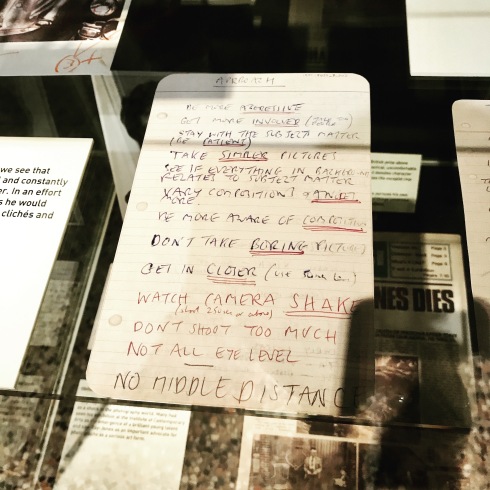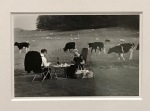The first thing I saw at the entrance to the gallery for this exhibition was a glass case filled with memorabilia from Tony-Ray Jones, a particular Martin Parr touch given his love for ephemera. In the cabinet was a handwritten note by Ray-Jones, presumably a note to himself to help him keep focus on what was important in his photographic approach. It was something that immediately resonated with me and an important portal into the photographer’s passion and mindset:

Approach:
Be more aggressive
Get more involved (talk to people)
Stay with the subject matter (be patient)
Take simpler pictures
See if everything in background relates to the subject matter
Vary composition and angles more
Be more aware of competition
Don’t take boring pictures
Get in closer (use 50mm lens)
Watch camera shake (shoot 250 sec or above)
Don’t shoot too much
Not all eye level
No middle distance
This impresses me completely – it feels like something I should print and put on the wall next to my workstation to remind me of what is important. It is also a sad reminder of the loss to photography Tony Ray-Jones’ early and sudden death was.
‘Only in England’ is an exhibition of photographs by Tony Ray-Jones, curated by Martin Parr shown alongside early Parr series ‘The Non-Conformists.’ The exhibition
notes describe Ray-Jones and Parr as “linked by a talent for social observation, [with photographs] rich in narrative and full of humour and melancholy.” In the film which accompanies the exhibition, Parr talks about the influence Ray-Jones had on him as a young man studying photography in 1972 with the focus on the idiosyncrasies of the English being shown through the influence of the American street photographers Ray-Jones studied during his time in the US in the 1960s.
The exhibition notes describe Ray-Jones’ aesthetic as distinctive due to his ability to organise chaos in the frame which enables him to compose his photographs instinctively, creating harmonious arrangements. Humour and juxtaposition are often present in the images along with an ambiguity due to his typical approach of leaving something obscured or out of the frame. To my eye, the influence of the energy of American street photography is evident in the pictures while also capturing the quirky nature of the English society at the time which was full of tensions being poised towards changing times.
For ‘The Non-Conformists’, Parr spent five years documenting the tightly knit community of Hebden Bridge, living in there and getting to know the community. Although stylistically there are similarities between the two photographers work, particularly the use of humour and juxtaposition, Parr is showing an insiders view, as opposed to Ray-Jones who approaches his subjects without prior knowledge photographing what he sees in from of himself as it unfolds. There is a commonality in the warmth that both photographers have for the people they photograph, interestingly, not something that Parr maintained as his later work is closer to Ray- Jones’ approach he also became more distant, perhaps even cruel, in his depictions. My knowledge of Parr’s later work and how it developed, and particularly the way his long career has enabled a body of work to become built around recurring themes made me wonder how Ray-Jones would have changed and evolved over time – a thought which both adds to the appreciation of the legacy he left behind and aware of the loss to photography his early and sudden death was.




























